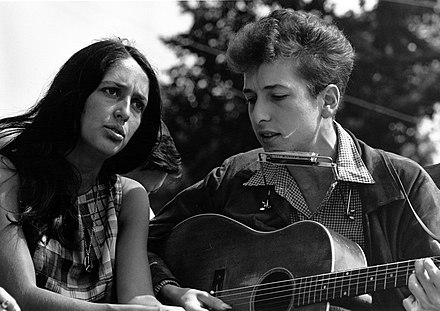Portal:Civil rights movement
The civil rights movement portal_-_NARA_-_542010.jpg/440px-Civil_Rights_March_on_Washington,_D.C._(Leaders_marching_from_the_Washington_Monument_to_the_Lincoln_Memorial)_-_NARA_-_542010.jpg) The civil rights movement was a social movement and campaign from 1954 to 1968 in the United States to abolish legalized racial segregation, discrimination, and disenfranchisement in the country. The movement had its origins in the Reconstruction era during the late 19th century and had its modern roots in the 1940s, although the movement made its largest legislative gains in the 1960s after years of direct actions and grassroots protests. The social movement's major nonviolent resistance and civil disobedience campaigns eventually secured new protections in federal law for the civil rights of all Americans. After the American Civil War and the subsequent abolition of slavery in the 1860s, the Reconstruction Amendments to the United States Constitution granted emancipation and constitutional rights of citizenship to all African Americans, most of whom had recently been enslaved. For a short period of time, African-American men voted and held political office, but as time went on Blacks were increasingly deprived of civil rights, often under the racist Jim Crow laws, and African Americans were subjected to discrimination and sustained violence by white supremacists in the South. Over the following century, various efforts were made by African Americans to secure their legal and civil rights, such as the civil rights movement (1865–1896) and the civil rights movement (1896–1954). The movement was characterized by nonviolent mass protests and civil disobedience following highly publicized events such as the lynching of Emmett Till. These included boycotts such as the Montgomery bus boycott, "sit-ins" in Greensboro and Nashville, a series of protests during the Birmingham campaign, and a march from Selma to Montgomery. At the culmination of a legal strategy pursued by African Americans, in 1954 the Supreme Court struck down the underpinnings of laws that had allowed racial segregation and discrimination to be legal in the United States as unconstitutional. The Warren Court made a series of landmark rulings against racist discrimination, including the separate but equal doctrine, such as Brown v. Board of Education (1954), Heart of Atlanta Motel, Inc. v. United States (1964), and Loving v. Virginia (1967) which banned segregation in public schools and public accommodations, and struck down all state laws banning interracial marriage. The rulings played a crucial role in bringing an end to the segregationist Jim Crow laws prevalent in the Southern states. In the 1960s, moderates in the movement worked with the United States Congress to achieve the passage of several significant pieces of federal legislation that authorized oversight and enforcement of civil rights laws. The Civil Rights Act of 1964 explicitly banned all discrimination based on race, including racial segregation in schools, businesses, and in public accommodations. The Voting Rights Act of 1965 restored and protected voting rights by authorizing federal oversight of registration and elections in areas with historic under-representation of minority voters. The Fair Housing Act of 1968 banned discrimination in the sale or rental of housing. (Full article...) Selected article -The Dream, also known as the Dr. Martin Luther King Jr. Memorial Sculpture, is an outdoor bronze sculpture of Martin Luther King Jr. by Michael Florin Dente, located outside the Oregon Convention Center in Portland, Oregon. The 8-foot (2.4 m) memorial statue was dedicated on August 28, 1998, the 35th anniversary of King's "I Have a Dream" speech. It depicts King plus three allegorical sculptures: a man who symbolizes the American worker, a woman who represents immigration, and a young girl shown releasing King's coattail, who represents, according to Dente, the "letting go" that occurs when people sacrifice their time and energy to engage in a struggle. The sculpture is part of the City of Portland and Multnomah County Public Art Collection, courtesy of the Regional Arts & Culture Council. Lee P. Brown and Vera Katz, mayors of Houston and Portland, respectively, were present at the dedication ceremony. The memorial has been used as a reference point for gatherings. It has also appeared in public art guides and walking tours. Seventy-five bronze replicas of the work exist, and Dente planned to send pieces of the original mold to each of the replicas' owners once all were sold. (Full article...)General imagesThe following are images from various civil rights movement-related articles on Wikipedia.
Related portalsWikiProjectsSelected biography -
Odetta Holmes (December 31, 1930 – December 2, 2008), known as Odetta, was an American singer, often referred to as "The Voice of the Civil Rights Movement". Her musical repertoire consisted largely of American folk music, blues, jazz, and spirituals. An important figure in the American folk music revival of the 1950s and 1960s, she influenced many of the key figures of the folk-revival of that time, including Bob Dylan, Joan Baez, Mavis Staples, and Janis Joplin. In 2011 Time magazine included her recording of "Take This Hammer" on its list of the 100 Greatest Popular Songs, stating that "Rosa Parks was her No. 1 fan, and Martin Luther King Jr. called her the queen of American folk music." (Full article...)
Selected image - Dr. Martin Luther King giving his "I Have a Dream" speech during the March on Washington for Jobs and Freedom in Washington, D.C., on 28 August 1963.
Did you know?
TopicsSubcategoriesThings to doEdit the tasks list
Associated WikimediaThe following Wikimedia Foundation sister projects provide more on this subject:
Discover Wikipedia using portals
|


_-_NARA_-_542056.jpg/440px-Civil_Rights_March_on_Washington,_D.C._(Leaders_of_the_march)_-_NARA_-_542056.jpg)











_-_NARA_-_542018.jpg/440px-Civil_Rights_March_on_Washington,_D.C._(Actor_Ossie_Davis.)_-_NARA_-_542018.jpg)


_-_NARA_-_542019.jpg/440px-Civil_Rights_March_on_Washington,_D.C._(Entertainment,_Vocalists_Peter,_Paul,_and_Mary.)_-_NARA_-_542019.jpg)


.jpg/440px-Civil_Rights_March_on_Washington,_D.C._(Leaders_of_the_march_posing_in_front_of_the_statue_of_Abraham_Lincoln..._-_NARA_-_542063_(cropped).jpg)




.jpg/440px-Convicts_(1903).jpg)

.jpg/440px-Civil_rights_demonstration_in_front_of_a_segregated_theater_Tallahassee,_Florida_(6847006931).jpg)
.jpg/440px-Odetta_(1961).jpg)













